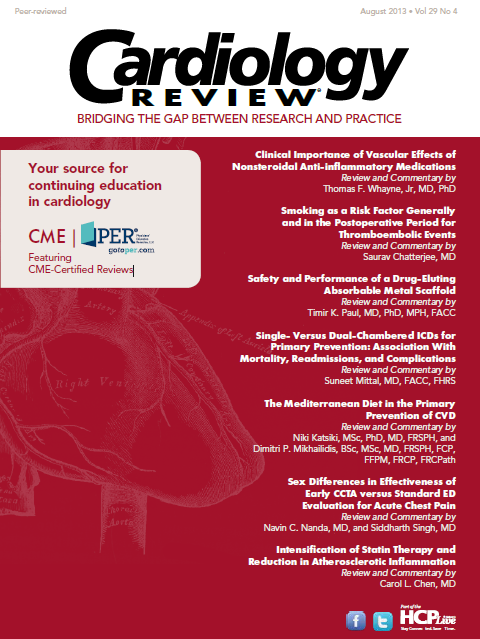How Should the Findings from the Mikus et al Study be Translated into Clinical Practice?
In this department of Cardiology Review we ask several clinicians to answer a question of current interest to health care practitioners.We asked 3 Cardiology Review editorial board members to comment on the recent study in the Journal of the American College of Cardiology by Mikus and colleagues, which showed that treatment with simvastatin 40 mg/d for as few as 12 weeks was associated with a marked reduction in response to an aerobic exercise training program. The study also suggests that the impaired training response may be due to statin-induced reductions in skeletal muscle mitochondrial content and oxidative capacity.Please send your comments or suggestions for future questions to Dr. Mukherjee at debabrata. mukherjee@ttuhsc.edu. Space permitting, we will post them online and in the iPad edition of the next issue.
Q: How should the findings from the Mikus et al study be translated into clinical practice?

Ragavendra R. Baliga, MD,
MBA, FACP, FRCP (Edin), FACC
Assistant Division Director
Professor of Internal Medicine
The Ohio State University Medical Center
Columbus, OH
A: It is well recognized that statins cause muscle ache, myositis, and rhabdomyolysis,1 often leading to discontinuation of these life-saving medications. Exercise training is associated with statin intolerance. In 1 study only 6 of 22 professional soccer players with familial hypercholesterolemia were able to tolerate any of the 5 statins then available.2 Several mechanisms of the statin-induced muscle dysfunction have been postulated, including mitochondrial dysfunction, abnormalities of cholesterol in the endoplasmic reticulum and sarcolemma, decreases in fat catabolism, increased concentrations of plant and cholesterol sterols in muscle cell, impaired reparative responses to damaged skeletal muscle, inflammation, deficiency of vitamin D, and decreased synthesis of prenylated proteins such as mitochondrial coenzyme Q10.3
A recent article in the Journal of the American College of Cardiology investigated the impact of exercise training on mitochondria in individuals with statininduced muscle dysfunction.4 The investigators randomized statin-naïve, previously sedentary adults with at least 2 risk factors for metabolic syndrome to 12 weeks of supervised aerobic training in combination with 40 mg/d of simvastatin (n = 18). The control group also participated in aerobic exercise training but did not receive statins (n = 19). They found that (a) maximal oxygen uptake increased 10% with training in the exercise-only group, but only 1.5% in the exercise and simvastatin group (P <0.01 for interaction), (b) muscle mitochondrial content (as measured by citrate synthase activity) obtained from vastus lateralis biopsies increased 13% following exercise training in the exercise-only subjects but decreased 4.5% in the subjects in the exercise plus statin group (P <0.05 for interaction), and (c) there were changes in skeletal muscle mitochondrial complexes I, II, III, and IV with exercise training alone, but no changes with exercise training and statin treatment. An editorial accompanying this article3 commented that knowing whether there was reduced intensity of training in statin-treated subjects in this trial would indicate if statins reduced the physiological response to a similar training stimulus or if they reduced the training stimulus itself.
There is a substantial incremental mortality benefit of exercise in individuals on statin therapy.5,6 However, if patients are unable to tolerate statins, a situation that occurs with competitive athletes, then these individuals lose the benefit of statin therapy. In my own clinical practice I have staggered the statin dose to alternate days or even 2 times a week7-10 in those who develop myalgia so that they get some benefit from statin therapy. Further studies are needed to determine whether such an approach reduces cardiovascular events in those who are intolerant to statins due to myalgias.
References
1. Baliga RR. Statin prescribing guide. New York: Oxford University Press; 2010.
2. Sinzinger H, O’Grady J. Professional athletes suffering from familial hypercholesterolaemia rarely tolerate statin treatment because of muscular problems. Br J Clin Pharmacol. 2004;57:525-528.
3. Thompson PD, Parker B. Statins, exercise, and exercise training. J Am Coll Cardiol. 2013. doi:10.1016/ .jacc.2013.03.030.
4. Mikus CR, Boyle LJ, Borengasser SJ, et al. Simvastatin impairs exercise training adaptations [published online April 10, 2013]. J Am Coll Cardiol. pii: S0735-1097(13) 01403-4. doi: 10.1016/j.jacc.2013.02.074.
5. Kokkinos PF, Faselis C, Myers J, Panagiotakos D, Doumas M. Interactive effects of fitness and statin treatment on mortality risk in veterans with dyslipidaemia: a cohort study. Lancet. 2013;381:394-399.
6. Nylen ES, Faselis C, Kheirbek R, Myers J, Panagiotakos D, Kokkinos P. Statins modulate the mortality risk associated with obesity and cardiorespiratory fitness in diabetics. J Clin Endocrinol Metab. 2013.
7. Kennedy SP, Barnas GP, Schmidt MJ, Glisczinski MS, Paniagua AC. Efficacy and tolerability of once-weekly rosuvastatin in patients with previous statin intolerance. J Clin Lipidol. 2011;5:308-315.
8. Ruisinger JF, Backes JM, Gibson CA, Moriarty PM. Once-a-week rosuvastatin (2.5 to 20 mg) in patients with a previous statin intolerance. Am J Cardiol. 2009;103:393- 394.
9. Jafari M, Ebrahimi R, Ahmadi-Kashani M, Balian H, Bashir M. Efficacy of alternate-day dosing versus daily do.sing of atorvastatin. J Cardiovasc Pharmacol Ther. 2003;8:123-126.
10. Matalka MS, Ravnan MC, Deedwania PC. Is alternate daily dose of atorvastatin effective in treating patients with hyperlipidemia? the alternate day versus daily dosing of atorvastatin study (ADDAS). Am Heart J. 2002;144:674- 677.
Q: How should the findings from the Mikus et al study be translated into clinical practice?

Sucheta Gosavi, MD
Assistant Professor of Internal Medicine
Texas Tech University Health Sciences Center
El Paso, TX
A: In the last few years, several studies have shown decreased cardiovascular mortality with administration of statins. Hence, statins have become the mainstay for treatment of cardiovascular and cerebrovascular disease. As a result of these studies, statins have been liberally used even for patients who may not be at high risk for cardiovascular disease. The recent study by Mikus et al, and an editorial accompanying the article, on statins, exercise, and exercise training,1,2 has brought attention to the issue of exercise and statins and the risks involved with statins when used in a larger population.
Studies show that patients taking statins who perform vigorous exercise have greater rates of myopathy than statin users who do not perform heavy exercise. Mikus et al showed that 40 mg/d of simvastatin in overweight or obese persons with at least 2 risk factors of metabolic syndrome who engaged in supervised aerobic exercise had decreased levels of citrate synthase in skeletal muscle sarcolemma. The investigators also found decreased peak oxygen consumption compared with similar individuals having at least 2 risk factors for metabolic syndrome who performed the same exercise but without statins. Decrease in skeletal muscle mitochondrial content and oxidative capacity have been seen in previous studies with simvastatin, atorvastatin, and fluvastatin.3-6
Another recent study by Ishak Mansi and colleagues also concluded that musculoskeletal conditions, arthropathies, injuries, and pain were increased in patients taking statins for at least 90 days.7 However, in the recent study by Parker et al, patients taking 80 mg atorvastatin for 6 months showed increased creatine kinase, but no decrease in average muscle strength.8 Urso and colleagues9 showed that statins enhance protein degradation via a ubiquitin protease pathway. It has been postulated that statins cause instability of the skeletal muscle cell membranes, and when exercise is performed upon these cells that were already exposed to statins, the proteolytic cascades are activated, resulting in muscle damage.9 The question then arises: should these patients who exercise and also take statins be given coenzyme Q10 supplementation, which helps to keep the levels of ubiquitin high and prevent myopathy?
The recent meta-analysis of 27 randomized trials of statin and vascular disease showed that even in low-risk individuals each 1 mmol/L absolute reduction in LDL cholesterol produced a reduction in major vascular events of about 11 per 1,000 over 5 years. This benefit greatly exceeds any known hazards of statin therapy.10
Thus, considering all the evidence about statins and exercise, it appears that one should customize the treatment of statins for people who can exercise and for those who cannot. Those who can exercise and still need statins due to other high-risk factors for vascular disease should probably be given rosuvastatin or pravastatin, which are water soluble and thus have less entry into the cell membranes.11 Coenzyme Q10 supplementation should be more strongly considered in those individuals who cannot afford these 2 medications and are taking the generic statins. Low doses of these generic statins may also be an option. Rosuvastatin with exercise has been shown to preserve coenzyme Q10 levels along with increasing high-density lipoprotein cholesterol in patients with CAD.12 Since the benefits of statins for dyslipidemia outweigh the risk associated with exercise, one should probably continue them even if the patient performs heavy exercise, unless they develop myopathy. Monitoring the levels of creatine kinase in these patients at periodic intervals should be performed to prevent myopathy. Thus physicians and patients should be educated about statins and highintensity exercise. Whether statins are indicated in low-risk individuals remains a question and should be considered after more randomized controlled studies.
References
1. Mikus CR, Boyle LJ, Borengasser SJ, et al. Simvastatin impairs exercise training adaptations. J Am Coll Cardiol. 2013. doi:10.1016/j.jacc.2013.02.074.
2. Thompson PD, Parker B. Statins, exercise and exercise training. J Am Coll Cardiol. 2013. doi:10.1016. jacc.2013.03.030.
3. Sirvent P, Mercier J, Vassort G, Lacampagne A. Simvastatin triggers mitochondria-induced Ca2+ signaling alteration in skeletal muscle. Biochem Biophys Res Commun. 2005: 329:1067-1075.
4. Dirka AJ, Jones KM. Statin-induced apoptosis and skeletal myopathy. Am J Physio Cell Physiol. 2006; 291:1208-1212.
5. Sirvent P. Borenave S, Vermaelen M et al. Simvastatin induces impairment in skeletal muscle while heart is protected. Biochem Biophys Res Commun. 2005;338:1426- 1434.
6. Wu JS, Buettner C, Smithline H, Ngo LH, Greenman RL. Evaluation of skeletal muscle during calf exercise by 31-phosphorus magnetic resonance spectroscopy in patients on statin medications. Muscle Nerve. 2011;43:76- 81.
7. Mansi I, Frei CR, Makris U, Mortensen EM. Statins and musculosketal conditions, arthropathies and injuries. JAMA. 2013. doi:10.1001/jamainternmed.2013.6184.
8. Parker BA, Capizzi MS, Grimaldi BS, et al. Effect of statins on skeletal muscle function. Circulation. 2013;127:96-103.
9. Urso ML. Clarkson PM, Hittel D, Hoffman EP, Thompson PD. Changes in ubiquitin proteasome pathway gene expression in skeletal muscle with exercise and statins. Arterioscler Thromb Vascular Biol. 2005;25:2560-2566.
10. Cholesterol Treatment Trialists’ Collaborators. The effects of lowering LDL cholesterol in people at low risk of vascular disease: meta-analysis of individuals data from 27 randomised trials. Lancet. 2012;380:581-590.
11. Thompson PD, Clarkson PM, Karas RH. Statinassociated myopathy. JAMA. 2003:289;1681-1690.
12. Toyama K, Sugiyama S, Oka Hideki, Iwasaki Y, Sumida H, et al. Rosuvastatin combined with regular exercise preserves coenzyme Q10 levels associated with a significant increase in high-density lipoprotein cholesterol in patients with coronary artery disease. Atherosclerosis. 2011;217:158-164.
Q: How should the findings from the Mikus et al study be translated into clinical practice?

Michael W. Rich, MD
Professor of Medicine
Washington University School of Medicine
St. Louis, MO
A: About a year ago, after taking statins religiously (for many cardiologists, statins are a religion) for over 15 years, I quit “cold turkey.” Why? The main reason was that I was concerned about my memory. But it had also gotten to the point where I could no longer run due to calf cramps and Achilles tendonitis. And guess what? Within a few weeks the cramps resolved, the tendonitis improved, and I was able to run again. I think my memory’s better, too, although I’m not sure my wife would agree.
The prevalence of statin-related muscle side effects reported in clinical trials is in the range of 5% to 10%. Yet in clinical practice it seems to be much higher, and up to 50% of patients discontinue statins within 1 year, most commonly due to perceived adverse effects.1 Moreover, as noted by Thompson and Parker,2 statin intolerance due to muscle side effects appears to be more common in individuals who participate in intense sports (eg, soccer),3 and muscle injury occurring during endurance exercise, such as long-distance running, may be potentiated by statins.4 Statin use has also been associated with reduced physical activity in middle-age and older adults.5
Now, in an elegant study reported in the Journal of the American College of Cardiology, Mikus and colleagues showed that treatment with simvastatin 40 mg daily for as few as 12 weeks was associated with a marked reduction in response to an aerobic exercise training program.6 Furthermore, the investigators found that the impaired training response may be due to statin-induced reductions in skeletal muscle mitochondrial content and oxidative capacity. The implication of these findings is that the known health benefits of regular exercise, at least with respect to improving cardiorespiratory fitness, may be attenuated by statins.
How should these findings be translated into clinical practice? Fortunately, there is good evidence from observational studies that the combination of exercise and statins is associated with lower mortality than either exercise or statin therapy alone.7 Therefore, from the population perspective, it seems appropriate to continue to advise people of all ages to engage in regular exercise in accordance with current guidelines, and to prescribe statins when clinically indicated. But from the individual perspective, the potential for statins to adversely affect quality of life remains a prime consideration. This implies that prescription of statins, and particularly continuation of statins in the presence of side effects (however mild), should not be axiomatic, but rather should be a shared decision between the clinician and patient, acknowledging both the known benefits and potential harms. In my case, rightly or wrongly, I have chosen to forgo statins in favor of a perception of better quality of life.
In conclusion, despite the unequivocal benefits of statins in reducing cardiovascular morbidity and mortality in large subgroups of the population, there is a growing body of evidence that the adverse effects of statins on muscle function are clinically important, and that statins may have significant detrimental effects on metabolism and cognition as well.8,9 Additional research is needed to further elucidate the mechanisms of these adverse effects, and to determine if interventions, such as coenzyme Q10,10 can attenuate or eliminate these side effects.
References
1. Zhang H, Plutzky J, Skentzos S, et al. Discontinuation of statins in routine care settings: a cohort study. Ann Intern Med. 2013;158:526-534.
2. Thompson PD, Parker B. Statins, exercise, and exercise training. J Am Coll Cardiol. 2013. doi:10.1016.jacc.2013.03.030.
3. Sinzinger H, O’Grady J. Professional athletes suffering from familial hypercholesterolaemia rarely tolerate statin treatment because of muscular problems. Br J Clin Pharmacol. 2004;57:525-528.
4. Thompson PD, Zmuda JM, Domalik LJ, Zimet RJ, Staggers J, Guyton JR. Lovastatin increases exercise-induced skeletal muscle injury. Metabolism. 1997;46:1206-1210.
5. Parker BA, Capizzi JA, Grimaldi AS, et al. Effect of statins on skeletal muscle function. Circulation. 2013;127:96-103.
6. Mikus CR, Boyle LJ, Borengasser SJ, et al. Simvastatin impairs exercise training adaptations [published online April 10, 2013]. J Am Coll Cardiol. pii: S0735-1097(13)01403-4. doi:10.1016/j.jacc.2013.02.074.
7. Kokkinos PF, Faselis C, Myers J, Panagiotakos D, Doumas M. Interactive effects of fitness and statin treatment on mortality risk in veterans with dyslipidaemia: a cohort study. Lancet. 2013;381:394-399.
8. Evans MA, Golomb BA. Statin-associated adverse cognitive effects: survey results from 171 patients. Pharmacotherapy. 2009;29:800-811.
9. Sattar N, Preiss D, Murray HM, et al. Statins and risk of incident diabetes: a collaborative meta-analysis of randomised statin trials. Lancet. 2010;375:735-742.
10. Joy TR, Hegele RA. Narrative review: statin-related myopathy. Ann Intern Med. 2009;150:858-868.
